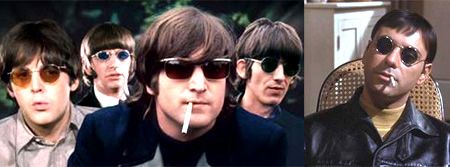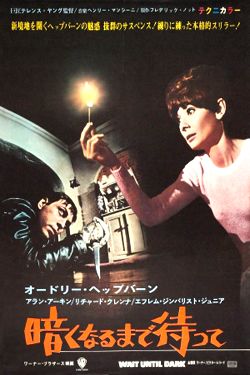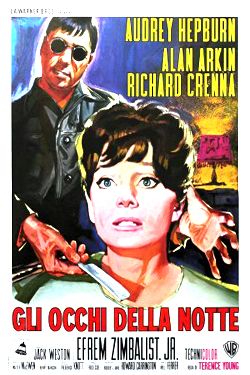← Back to Reviews
in
Plot – Photographer Sam Hendrix is returning from a plane trip when an encounter at the airport leaves him in possession of a doll. Unbeknownst to him the doll is stuffed with heroin. When he takes the doll home to his wife Susy (Hepburn), who was recently left blind, he has no idea of the danger he has placed her in,. They may not know about the heroin but the dangerous trio of Harry Roat (Arkin), Mike Talman (Crenna) and Carlino (Weston) do. Unable to locate the doll on their own they concoct an elaborate plan to have Susy herself reveal its location to them. Impersonating a series of character they attempt to manipulate the information out of her. But the blind Susy turns out to be much more resourceful than we, or they, could ever imagine.
This is a very intelligent and classy suspense thriller from Terence Young, director of three of the first four James Bond films. As I've said on here before I can trace most thrillers back to the Master of Suspense, Alfred Hitchcock, in some way or another but this one is more obvious than most. There's an immensely strong Hitchcock vibe to proceedings, with a few of the Master's films in particular feeling very much in the same vein as this effort from Bond veteran Terence Young. With its stagey feel and almost exclusive use of a single, one-apartment set there is an obvious link to the likes of Dial M for Murder and Rope. Like both of those films, Wait Until Dark also details a unique mystery where one set of characters holds more knowledge than the other person and attempts to manipulate the situation for their own good. And like Dial M for Murder, telephones will play a large part in proceedings. The other Hitch classic this evokes is 1954's Rear Window. Both films feature a hero who is restrained by a physical limitation which places them in a precarious position. In Rear Window, it was L.B. Jeffries' broken leg which confined him to his apartment, while here it is our heroine's blindness that places obstacles in her path. Such were the similarities to those films mentioned that it came as no real surprise to find that the man who wrote the original play, Frederick Knott, was also the man responsible for the story of Dial M for Murder.
Audrey Hepburn is terrific as Susy, creating one of my favourite screen heroines that I've seen in quite some time. First of all I will say that I haven't ever had any real contact with a blind person. Perhaps people who have would think differently of her performance, but I thought Hepburn's depiction of the blind Susy Hendrix was thoroughly impressive and convincing. She highlights the difficulties the character faces with her adjustment to her recent blindness, but shows her overcoming these trials to emerge as an independent and resourceful. She just imbues Susy with such depth and compassion as she depicts the weaknesses her blindness has created, but also some unexpected strengths. It's not just her performance that marks her out as an ideal piece of casting. Her appearance feels a perfect fit for the character. With her angelic face, pixie style hairdo and her thin, slight frame she seems like the natural choice to portray the character's fragile and frail demeanour and situation as that of a blind woman being terrorised and manipulated by the scheming trio.
As amazing as she is however, Hepburn almost has the movie stolen away from her by an uncharacteristically creepy Alan Arkin. In the role of the villainous Roat he is tremendously sleezy and threatening, bringing a really ominous sense of unease any time he appears on screen. His unique appearance just adds to his sadistic and threatening presence, particularly the fact that his eyes are constantly hidden. The most obvious comparison would have to be Jean Reno in Leon. However with his fringey moptop and sunglasses I got a real Beatles vibe from him. Add in the appropriate time frame of 1967 and I really think we might be looking at the evil fifth Beatle!!!  Take a look at my little mock-up below and see what you think. While it's the performances of Hepburn and Arkin that you'll come away remembering, they are given strong back-up in the form of the supporting cast of Richard Crenna, Jack Weston and young Julie Herrod.
Take a look at my little mock-up below and see what you think. While it's the performances of Hepburn and Arkin that you'll come away remembering, they are given strong back-up in the form of the supporting cast of Richard Crenna, Jack Weston and young Julie Herrod.

I admire the film for not taking the easy route in its attempts to build tension. It doesn't pepper the film with jump scares, or scenes of easy tension where sy a character is waiting in a room with a gun for someone to enter. The film takes its time and really delivers a slow build. The opening half hour in particular is really rather ponderous and wordy, and I felt myself struggling with it, wondering what I was in for. However I would certainly advise anyone to stick with it as it's certainly worth it. Once it's taken its considerable time to set out the game we're playing and all of the players, you get a really intelligent and gripping experience which kept me fascinated right until the end. Even if you ignore the film's fashion and décor you can still tell Wait Until Dark is at least 30 years old just as a result of this approach. There's no way I could see this film being made today in such a fashion, with such a subtle, slow build. Oh and while talking about the tense and gripping nature of the film, I have to give major credit to Henry Mancini. His haunting, ominous score goes a long way to creating that atmosphere throughout the film. And then he tops himself by really turning the screws for the superb finale which I'll talk about in a moment. While I'm handing out credit to the crew, Terence Young deserves credit for his smart direction and staging which ensures that not only is the single bed apartment set not a hindrance for the film but actually a strength.
And after that slow build, it then ramps things up spectacularly for the final showdown between Hepburn and Arkin. It's such a tense, edge of the seat close for the film and I just loved it. Having now worked out what is going on, Susy realises the danger she is in and does what she can to even the odds. In a bid to even the playing field, Susy attempts to smash all of the lights in the apartment, placing Roat in the same darkness as she experiences. With a large chunk of the sequence taking place in either total darkness or by the mere flicker of a lit match, it really is terrifically tense and suspenseful trying to determine what is actually going on and waiting to see what the outcome will be. And just when you think Roat is defeated, he returns from off-screen with a chilling leap at Susy. I'm not alone in admiring Wait Until Dark's finale. The heart-stopping climax ranked tenth on Bravo's 100 Scariest Movie Moments, and in "The Book of Lists: Horror", Stephen King placed the confrontation between Hepburn and Arkin at #1 on his list. At the time of its release, some theatres actually turned off all the lights in the cinema to heighten the fear and panic of the audience. That would have been quite cool to experience.
Conclusion – This is a cracking thriller. Smart direction, some powerhouse performances and an effective score go a long way to creating a menacing and gripping experience. Highly recommened stuff if you can get past its initially slow burn. While I'm guessing it's fairly obvious from my score and review that I was pretty enamoured with the film on this, my initial viewing, there's something about the film that makes me think it's one that could really grow on me into a true favourite.

|

|
Year of release
1967
1967
Directed by
Terence Young
Terence Young
Written by
Robert Carrington (script)
Jane-Howard Carrington (script)
Frederick Knott (play)
Robert Carrington (script)
Jane-Howard Carrington (script)
Frederick Knott (play)
Starring
Audrey Hepburn
Richard Crenna
Alan Arkin
Jack Weston
Audrey Hepburn
Richard Crenna
Alan Arkin
Jack Weston
Wait Until Dark
Plot – Photographer Sam Hendrix is returning from a plane trip when an encounter at the airport leaves him in possession of a doll. Unbeknownst to him the doll is stuffed with heroin. When he takes the doll home to his wife Susy (Hepburn), who was recently left blind, he has no idea of the danger he has placed her in,. They may not know about the heroin but the dangerous trio of Harry Roat (Arkin), Mike Talman (Crenna) and Carlino (Weston) do. Unable to locate the doll on their own they concoct an elaborate plan to have Susy herself reveal its location to them. Impersonating a series of character they attempt to manipulate the information out of her. But the blind Susy turns out to be much more resourceful than we, or they, could ever imagine.
This is a very intelligent and classy suspense thriller from Terence Young, director of three of the first four James Bond films. As I've said on here before I can trace most thrillers back to the Master of Suspense, Alfred Hitchcock, in some way or another but this one is more obvious than most. There's an immensely strong Hitchcock vibe to proceedings, with a few of the Master's films in particular feeling very much in the same vein as this effort from Bond veteran Terence Young. With its stagey feel and almost exclusive use of a single, one-apartment set there is an obvious link to the likes of Dial M for Murder and Rope. Like both of those films, Wait Until Dark also details a unique mystery where one set of characters holds more knowledge than the other person and attempts to manipulate the situation for their own good. And like Dial M for Murder, telephones will play a large part in proceedings. The other Hitch classic this evokes is 1954's Rear Window. Both films feature a hero who is restrained by a physical limitation which places them in a precarious position. In Rear Window, it was L.B. Jeffries' broken leg which confined him to his apartment, while here it is our heroine's blindness that places obstacles in her path. Such were the similarities to those films mentioned that it came as no real surprise to find that the man who wrote the original play, Frederick Knott, was also the man responsible for the story of Dial M for Murder.
Audrey Hepburn is terrific as Susy, creating one of my favourite screen heroines that I've seen in quite some time. First of all I will say that I haven't ever had any real contact with a blind person. Perhaps people who have would think differently of her performance, but I thought Hepburn's depiction of the blind Susy Hendrix was thoroughly impressive and convincing. She highlights the difficulties the character faces with her adjustment to her recent blindness, but shows her overcoming these trials to emerge as an independent and resourceful. She just imbues Susy with such depth and compassion as she depicts the weaknesses her blindness has created, but also some unexpected strengths. It's not just her performance that marks her out as an ideal piece of casting. Her appearance feels a perfect fit for the character. With her angelic face, pixie style hairdo and her thin, slight frame she seems like the natural choice to portray the character's fragile and frail demeanour and situation as that of a blind woman being terrorised and manipulated by the scheming trio.
Film trivia - The film's star, Hepburn, and its director, Terence Young, had a lengthy and incredible history. During World War II, a 16 year old Hepburn was a volunteer nurse at a Dutch hospital. During the battle of Arnhem, the hospital received many wounded Allied soldiers. One of the injured soldiers that Hepburn helped nurse back to health was a young British paratrooper who just happened to be named Terence Young. More than twenty years later that same paratrooper would then direct that same nurse in this film.
 Take a look at my little mock-up below and see what you think. While it's the performances of Hepburn and Arkin that you'll come away remembering, they are given strong back-up in the form of the supporting cast of Richard Crenna, Jack Weston and young Julie Herrod.
Take a look at my little mock-up below and see what you think. While it's the performances of Hepburn and Arkin that you'll come away remembering, they are given strong back-up in the form of the supporting cast of Richard Crenna, Jack Weston and young Julie Herrod. 
I admire the film for not taking the easy route in its attempts to build tension. It doesn't pepper the film with jump scares, or scenes of easy tension where sy a character is waiting in a room with a gun for someone to enter. The film takes its time and really delivers a slow build. The opening half hour in particular is really rather ponderous and wordy, and I felt myself struggling with it, wondering what I was in for. However I would certainly advise anyone to stick with it as it's certainly worth it. Once it's taken its considerable time to set out the game we're playing and all of the players, you get a really intelligent and gripping experience which kept me fascinated right until the end. Even if you ignore the film's fashion and décor you can still tell Wait Until Dark is at least 30 years old just as a result of this approach. There's no way I could see this film being made today in such a fashion, with such a subtle, slow build. Oh and while talking about the tense and gripping nature of the film, I have to give major credit to Henry Mancini. His haunting, ominous score goes a long way to creating that atmosphere throughout the film. And then he tops himself by really turning the screws for the superb finale which I'll talk about in a moment. While I'm handing out credit to the crew, Terence Young deserves credit for his smart direction and staging which ensures that not only is the single bed apartment set not a hindrance for the film but actually a strength.
And after that slow build, it then ramps things up spectacularly for the final showdown between Hepburn and Arkin. It's such a tense, edge of the seat close for the film and I just loved it. Having now worked out what is going on, Susy realises the danger she is in and does what she can to even the odds. In a bid to even the playing field, Susy attempts to smash all of the lights in the apartment, placing Roat in the same darkness as she experiences. With a large chunk of the sequence taking place in either total darkness or by the mere flicker of a lit match, it really is terrifically tense and suspenseful trying to determine what is actually going on and waiting to see what the outcome will be. And just when you think Roat is defeated, he returns from off-screen with a chilling leap at Susy. I'm not alone in admiring Wait Until Dark's finale. The heart-stopping climax ranked tenth on Bravo's 100 Scariest Movie Moments, and in "The Book of Lists: Horror", Stephen King placed the confrontation between Hepburn and Arkin at #1 on his list. At the time of its release, some theatres actually turned off all the lights in the cinema to heighten the fear and panic of the audience. That would have been quite cool to experience.
Conclusion – This is a cracking thriller. Smart direction, some powerhouse performances and an effective score go a long way to creating a menacing and gripping experience. Highly recommened stuff if you can get past its initially slow burn. While I'm guessing it's fairly obvious from my score and review that I was pretty enamoured with the film on this, my initial viewing, there's something about the film that makes me think it's one that could really grow on me into a true favourite.
Bonus Film trivia – As I noted earlier Wait Until Dark was originally a play. A revival of the play was staged in 1998 at the Brooks Atkinson Theatre, and ran for 97 performances. The cast included Marisa Tomei, Stephen Lang and most interestingly Quentin Tarantino!
